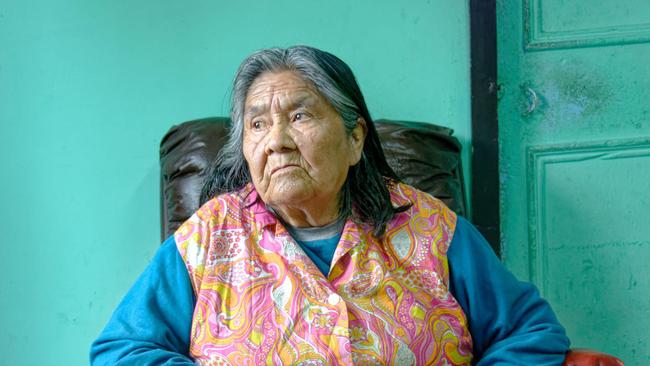Last of the Yahgans Cristina Calderón loses the race of life
Cristina Calderon, who has died aged 93, was the last full-blood descendant of the people observed by Charles Darwin when he reached the southernmost land on Earth.

For perhaps 10,000 years before Dutch sailor Willem Schouten became the first to successfully sail around the bottom of South America in 1616, the Yahgan people had lived among the 29,954 islands off the southern, Chilean side of the Patagonia peninsula.
Schouten named an abrupt rocky outcrop on one of the desolate islands Cape Horn. He had been born in Hoorn, north of Amsterdam, and a boat bearing that name had been the sister ship to his before being lost to fire. The cape is a forbidding place where the Pacific and Atlantic oceans violently heave at each other waves that can top 30m. More than 10,000 lives have been lost trying to round the world’s deadliest shortcut.
Somehow, the Yahgans eked out lives there following their food supply – shellfish, sea lions, birds’ eggs and, occasionally, llama-like guanacos – from island to island on small canoes. They wore no clothes despite the deafening squalls of violently shifting winds, and the sleet and ice. It is summer there now and Monday’s forecast is the pick of the week: a top temperature of 15, going down to 5, a couple of hours of sunshine and a severe westerly. The impenetrable fogs and bleak landscapes so depressed the HMS Beagle’s first young captain that he remained locked in his cabin for a month before shooting himself.
On the Beagle’s legendary second trip there, Charles Darwin would famously observe the Galapagos Islands finches and arrive at his theory of evolution. Only the fittest, with the right beaks adapted for survival, could cope.
But Darwin spent as much time observing the lives of the Yahgans in wonder about their frugal existence around the stone slopes, cold waters and in the freezing forests of the southernmost land on Earth. Spanish sailors had long seen from a distance the grudging fires the Yaghans managed to build along the coast despite the damp, and named the area Tierra del Fuego (Land of Fires). At first the locals people were called Fuegians, but they were four tribes with separate languages. Two of them, the Ona and the Haush, became extinct last century. There are no women of child-bearing age among the Alacaluf people, and, last Wednesday, Cristina Calderon, the last full-blood Yahgan and final speaker of their language, died aged 93.
Her hometown, Puerto Williams, hosts the Martin Gusinde Anthropological Museum, named after the remarkable Austrian Catholic priest and ethnologist who lived with and studied the tribes of southern Chile a century ago. He leaned on Calderon’s father for information about the Yahgan, whose numbers, never great, had been devastated from diseases brought there by Europeans.
By the age of seven, Calderon had been orphaned and was living with her impoverished grandparents. They could barely afford to feed the girl, but they taught her Yahgan culture and language. In those decades of coups and chaos across Chile, with military leaders who persecuted minorities, and rapacious settlers who fought with the locals, families often chose not to pass on their language. It was safer to give in and speak Spanish.
Just 15, Calderon was married off to an older man and was pregnant with his fourth child when he died of appendicitis in 1948. She had five children with her second husband, a shepherd and “a good man”, but he contracted tuberculosis, now believed to have been passed on to humans through the local sea lion population, dying in 1962. She married once more, to a shearer, a man she had known from childhood with whom she was again happy. With him she had her only daughter, Lidia, who was chosen to represent the Yahgan people at last year’s Chilean Constitutional Convention. Lidia’s father died 13 years ago.
Along the way Calderon learnt Spanish and English, and taught herself traditional Yahgan basket weaving, skills she passed on. With her sister, in 2005 she published a book of Yahgan tales and legends. With the help of a granddaughter, she published a dictionary of the Yahgan language and that granddaughter wrote Calderon’s life story published five years back.
Calderon died after contracting Covid-19 a few weeks ago, and with her some of the echoes of ancestry are also extinguished.
At first, Darwin dismissed the Yahgans as “savages” and “the troubled spirits of another world”. But decades later, after much contemplation, he wrote: “Their country is a broken mass of wild rock, lofty hills, and useless forests. Nature, by making habit omnipotent, and its effects hereditary, has fitted the Fuegian to the climate and the productions of his country.”
He encountered “Fuegians” long before he saw any finches. And it appears they also played a role in his life-defining theory.
One thing is for certain: in the modern-day version of survival of the fittest, the Yahgan people have lost.




To join the conversation, please log in. Don't have an account? Register
Join the conversation, you are commenting as Logout